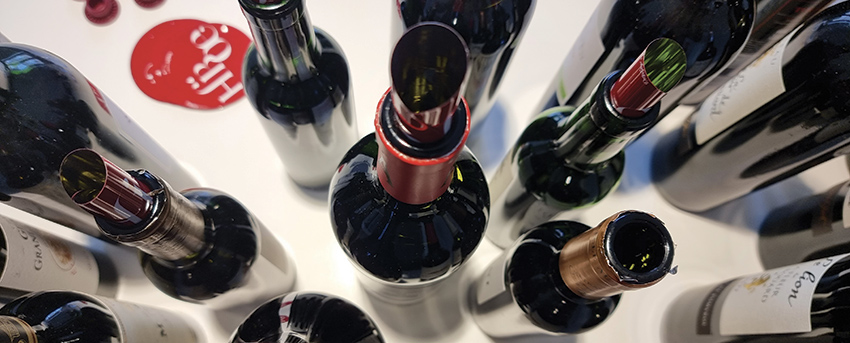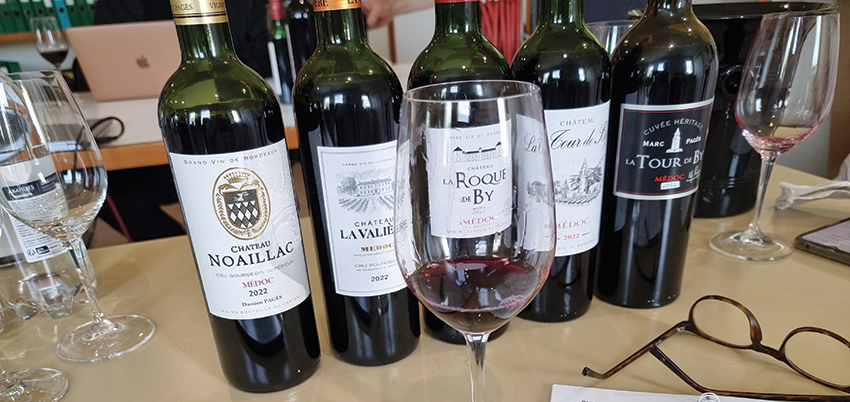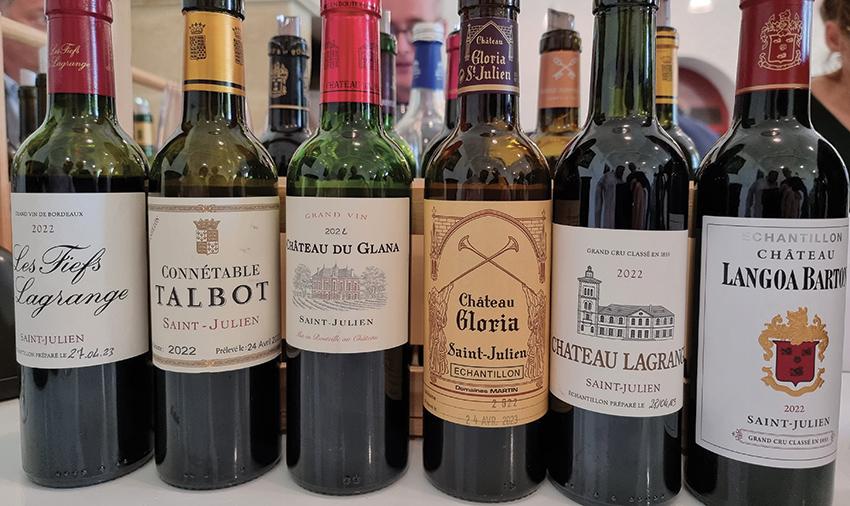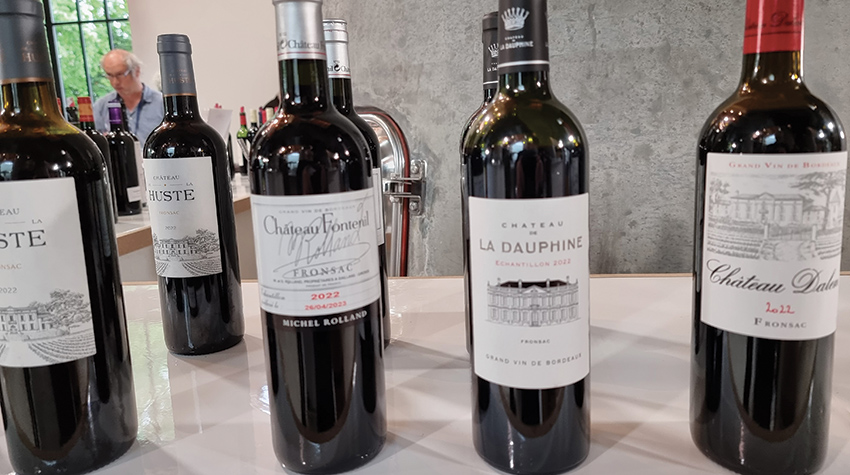
Cold, frost, rain, drought and strong sunshine were never to dictate their deleterious law and define this vintage. 2022 would once again reveal a powerfully resilient vineyard and winemaker. We had to adapt and imagine cultivation methods from other latitudes. The vintage is heterogeneous and, today more than ever, depends on the type of soil, but also on the way the vines are cultivated, the adoption of plant cover, the gentle and late pruning, the braiding rather than the trimming ... We agree that the vintage often made the winegrowers with a good sense of the land shine, the makers who are seriously in love with their vines and, in fine, we come back to this time and time again, the great terroirs.
We notice that in 2022, despite all predictions, the tannic mass brought freshness, which the thick skins of the grapes often protected from the burning sun. According to the consultant Stéphane Derenoncourt, “the result of this scorching summer was a clear-cut state of affairs”. However, it is certain that we are dealing with wines that are more luminous than sunny, wines that, according to the consultant, combine finesse and strength, complexity and depth. A great vintage? Perhaps. Out of the ordinary, certainly, with red grapes rich in tannins, anthocyanins and aromas. The reds should not have been rushed or over-extracted. The whites are quite heterogeneous but overall rather powerful and energetic. Once again this year, we can be convinced that neither the ageing nor the extractions were totally adequate responses to this vintage marked by drought.
Here, as elsewhere, it has been necessary to adapt to conditions that were sometimes Mediterranean in order to make this vintage a success. The management of the soil and the plants was essential in limiting soil compaction on the one hand, and protecting the grapes from the sun on the other. The harvest was very early, in the second half of August for the whites and at the beginning of September for the Merlot, and between 20 September and the beginning of October for the Cabernets.
Château Jean Faux is silky with perfect acidity and a beautiful finish, prolonged by liquorice and saline notes. We would also like to mention Château Lamothe-Vincent, followed by Oenoconseil, and its classy nose of dry leaves, undergrowth and ample body. In white, Château La Peyruche is a real success. The juice has a nice fatness and sparkling notes of ripe lemon. Château Lestage, a white from the Médoc, has exotic notes. The palate is fleshy with pear notes and a saline finish.

A vintage marked by light spring frosts, a mild spring with no mildew, a beautiful flowering period and a particularly hot and dry summer, barely disturbed by the storms at the end of August. The whites were harvested from August 19th. Although the quantities were small, the acidity was very present. The reds turned out to be colourful, concentrated and quite fresh when there was no blockage of maturity on the young vines or on the vines on soils with no water reserve. The whites, like all the wines in the region, are powerful in terms of aroma and full of acidity.
Château Haut-Selve, in red, stands out with an extraction that gently flirts with the limits, but maintains the wine in a rather floral and tense universe. Violet and liquorice dominate the palate. Château Cérons, in red, summons up floral elements and the palate proves to be lively and fresh. Château Cazebonne, in red, intrigues by its rather iconoclastic and drinkable side. We like its sapid and immediate juice. In white, Jean-Baptiste Duquesne of Château Cazebonne presents a wine of joyful density, spicy, terribly fresh and carried by its terroir and pretty Semillon. A real favourite for this pirate of the southern Graves. In a more classical register, we will stop at the lively and floral juice of Château Magneau. A fair and precise white.

“A vintage full of surprises. The degrees remain contained, the tannins surprise us with their melted, already seductive side, and the wines can be drunk young without affecting their ageing potential. A vintage that is reassuring about Bordeaux's ability to respond to global warming. The vines are resisting the scorching heat quite well, provided they have some water. After the rains at the end of June, we waited a long time for the summer storms, but they finally arrived before the harvest of the whites and then at the end of September to finish the maturity of the reds. This vintage also confirms that Bordeaux has some very good opportunities in its old or less old varieties: a silky Mancin, a fruity Bouchalès, a masterful Petit Verdot, a demonstrative Carmenere. They will be the perfect complement to the Cabernet Sauvignon blend”. Jean-Baptiste Duquesne du Château Cazebonne
Frost and drought have left their mark and impacted yields. A reduction essentially linked to the weight of the berries largely marked by the hydric stress. In white, the harvest started early with grapes showing good ripeness and good sugar-acidity balance. The PH and degrees, despite a sunny vintage - a summer up to 4° above the seasonal norms - remained modest to give fresh and balanced wines.
In white, Château Couhins, Cru Classé de Graves, still stands out a little with ripe fruit aromas and a welcome acidity. Château Luchey-Halde is a real success story of the AOC with its notes of eucalyptus, white flowers and citrus. A profile that breaks with the doxa. The red wine is the admirable Château Couhins, Cru Classé de Graves, crisp and tasty, with a conquering and fleshy middle palate. The grain is silky. Château Bardins evokes rose fragrances on the nose and is very fresh on the palate. The structure is curved, a little tight, but with a nice depth. Clos Marsalette has an elegant, tapering body that is not lacking in smoothness.
The véraison started very early on the early terroirs and the August temperatures accelerated the ripening of the berries, amplifying the concentration phenomena here too. Overall, 2022 was a very early vintage. Once again, the key to vinification was extraction, which had to be finely managed to avoid tannins. While 2022 is a warm vintage, it has good acid balance. The deep juices have silky tannic structures and interesting acidities. Here more than elsewhere, ageing will be important to avoid tannic masses.

Château de Malleret, Cru Bourgeois Exceptionnel in Haut-Médoc, has a creamy, round and already surprisingly charming palate. Château Cantemerle, a Grand Cru Classé in Haut-Médoc, has a more fluid, fresh juice with notes suggesting raspberry. The liquorice finish is magnificent.
A special mention for Château Rauzan-Ségla, Grand Cru Classé, which displays a dynamic and juicy wine, with fresh crushed fruit notes. The balance is already immense. Château Brane-Cantenac has a flattering juice with fine, light oak. A class of its own.
Château La Fleur Peyrabon, a Cru Bourgeois, invites us to feast our eyes on a fresh and precise juice. The initially tight tannins fade a little to allow us to bite into the sappy juice. The other great success is to be found in Château Grand Puy Ducasse, Grand Cru Classé. The wine here has a juice of striking depth. The tannins are powerful but of great finesse. The composition is remarkable in every aspect.
“2022 is a warm vintage but with a good acid balance, for which the control of extractions is a major issue. The ageing choices will be the great allies in taming this strong potential, they will be essential to avoid having too much tannin. 2022 is undeniably a great vintage, made for ageing”. Laboratoire Oenoconseil Pauillac.
The tannic structure of Château Meyney does not hide the presence of dense fruit, between elderberry and cherry. It is very elegant. The Château Lestage Darquier Grand Poujeaux, Moulis-en-Médoc, with its graceful and already round mouth, is a great success. A great success, to be continued.

In this hot and dry vintage, the buffering power of the clays revealed all its interest with a progressive release of the water contained in the soils. The hot weather in July slowed down the ripening process. The high temperatures in August, favoured the degradation of acids and the concentration of polyphenols during the ripening period. The vines demonstrated resilience thanks to the plant cover. As far as the winegrower had a good agronomic observation and searched for gustative balance, this hot vintage confirms that it will be a great Bordeaux vintage.
Château Larcis-Ducasse, 1er Grand Cru Classé de Saint-Emilion, is an undeniable success. The concentrated and creamy juice conjures up menthol and peony. It is very airy in spite of the dense matter. Château Fonroque, a Saint-Emilion Grand Cru Classé, remains the great representative of biodynamic viticulture in the AOC. The juice is pulpy and acidulous. The floral and spicy finish is immense. The quality of the tannins, the precise and fresh juice of Château La Grâce Dieu des Prieurs, Saint-Emilion Grand Cru, make it a real success. Château Monlot, Saint-Emilion Grand Cru, seduces by its grain and its great homogeneity. To be continued.
Château Croix de Labrie, Saint-Emilion Grand Cru Classé: a great and beautiful wine, with a beautiful aromatic palette, a juicy mouth supported by supple and subtle tannins.
Domaine Simon Blanchard Au Champ de la Fenêtre is a juicy and surprisingly chalky wine. A rare nugget and perfect expression of a mature Cabernet Franc. In a more classic register, Vieux Château Palon, comes out perfectly around an elegant tannic structure and breeding notes that are finally quite elegant.

Château Mazeyres is one of the great successes of the AOC. The fruit is explosive, fleshy and long. The mouth is sparkling with orange and rose notes. Château La Commanderie is a stunning wine of springtime freshness. The beautifully grainy frame is wrapped around fresh fruit and rose-like notes. Château Saint-Pierre, from clay-sand soils, makes its mark with a crisp, finely liquoriced palate with a perfect tannic base.
Although we might be repeating ourselves from one year to the next, we will remember the Domaine de l'A, carried by a delicate tannic structure and a fleshy, ample body. Very silky at the end. The Château Claud Bellevue has a crisp, fresh juice. A luminous expression of the AOC.

Château La Dauphine, Fronsac, reveals pretty floral notes on the nose, including violets. The tannins are fine and have a particularly elegant patina. A lovely wine. Château Marsau, in Francs, makes a very broad and suave Merlot. Once the tannins have softened, we will have a fine representative of the AOC. We will give a special mention to the other AOC representative, Château Puygueraud, floral and perfectly mature and round.
A vintage that should make us forget 2021, whose volumes were ridiculously low. 2022 is undeniably invited to the table of the great vintages of the last ten years. The botrytis is of a very high quality. We'll throw our lot in with Raymon-Lafon with its superb roasted nose and gingerbread fragrances. The palate is honey-coloured and of surprising volume. Château Guiraud is very accomplished with delicious candied notes. The juice is suave, creamy and incredibly precise.

Château La Fleur de Pins with 90% Semillon and 10% Sauvignon Blanc expresses voluptuous aromas of summer fruits. White peach and apricot are found on the palate. It is elegant and fresh from start to finish. A real success for this confidential AOC.
Henry Clemens
The dynamic Alliance des Récoltants presented in the cellars of Château Barre Gentillot the vintages of more than 30 winegrowers. A unique opportunity to meet and taste the wines of all the Bordeaux AOCs.